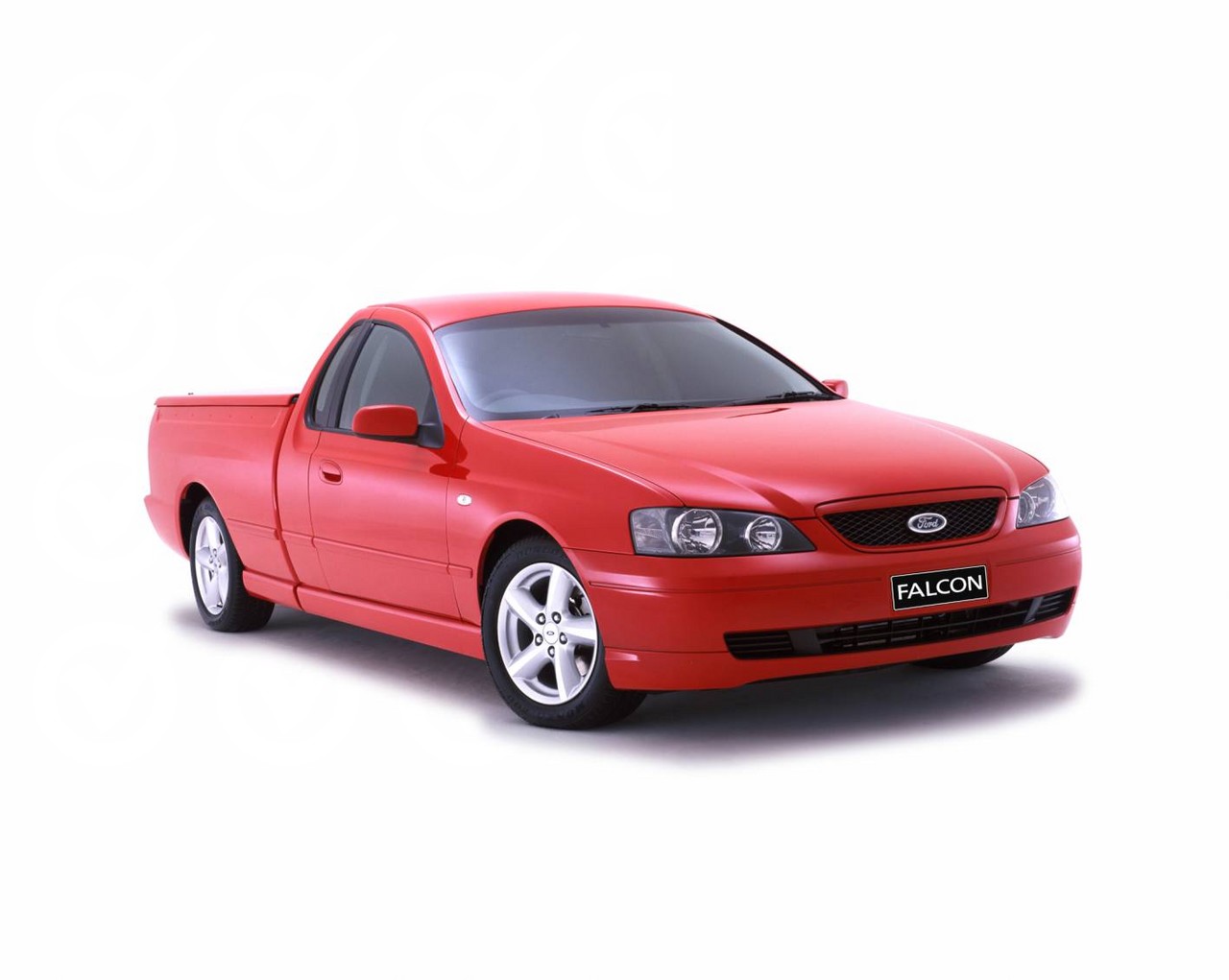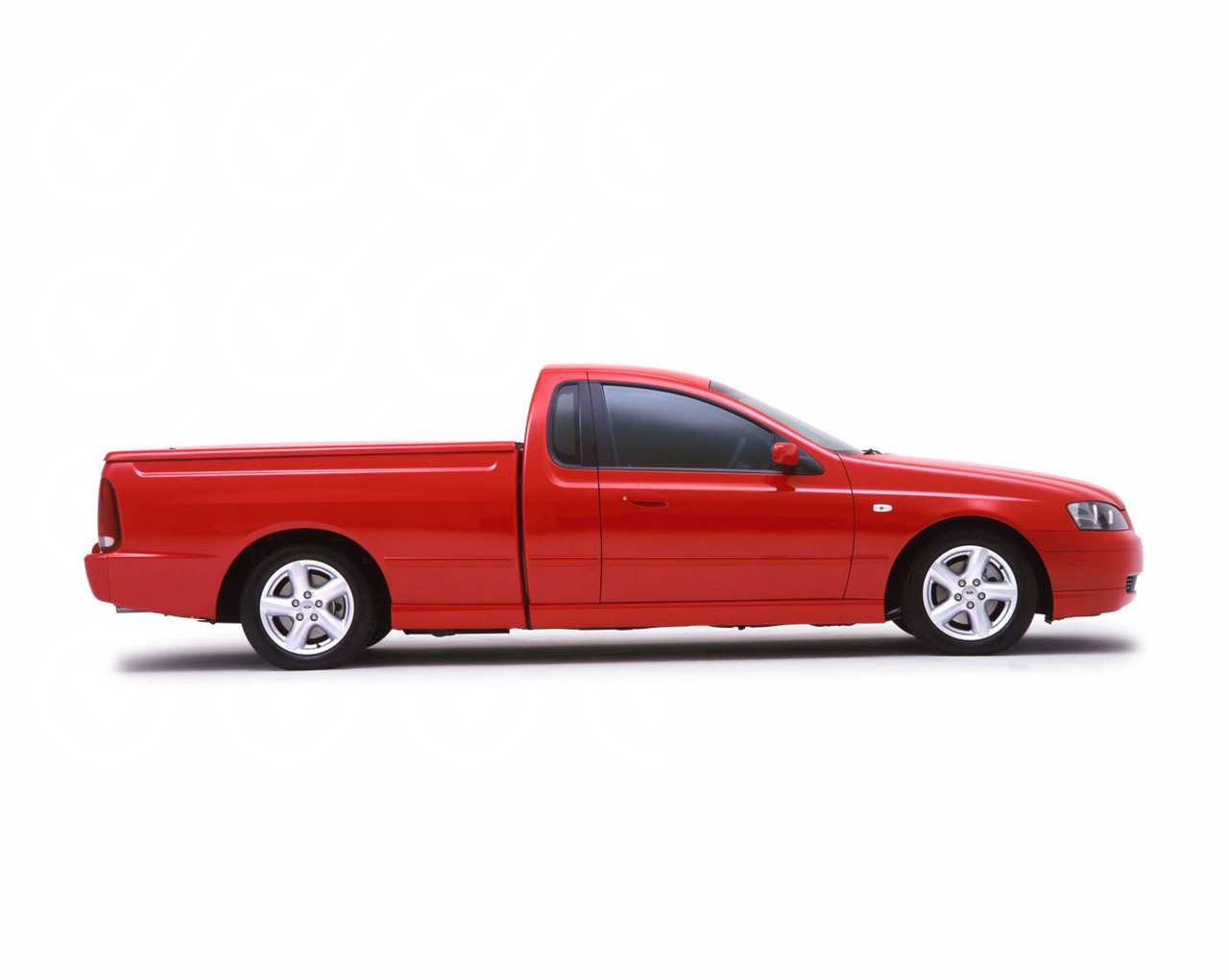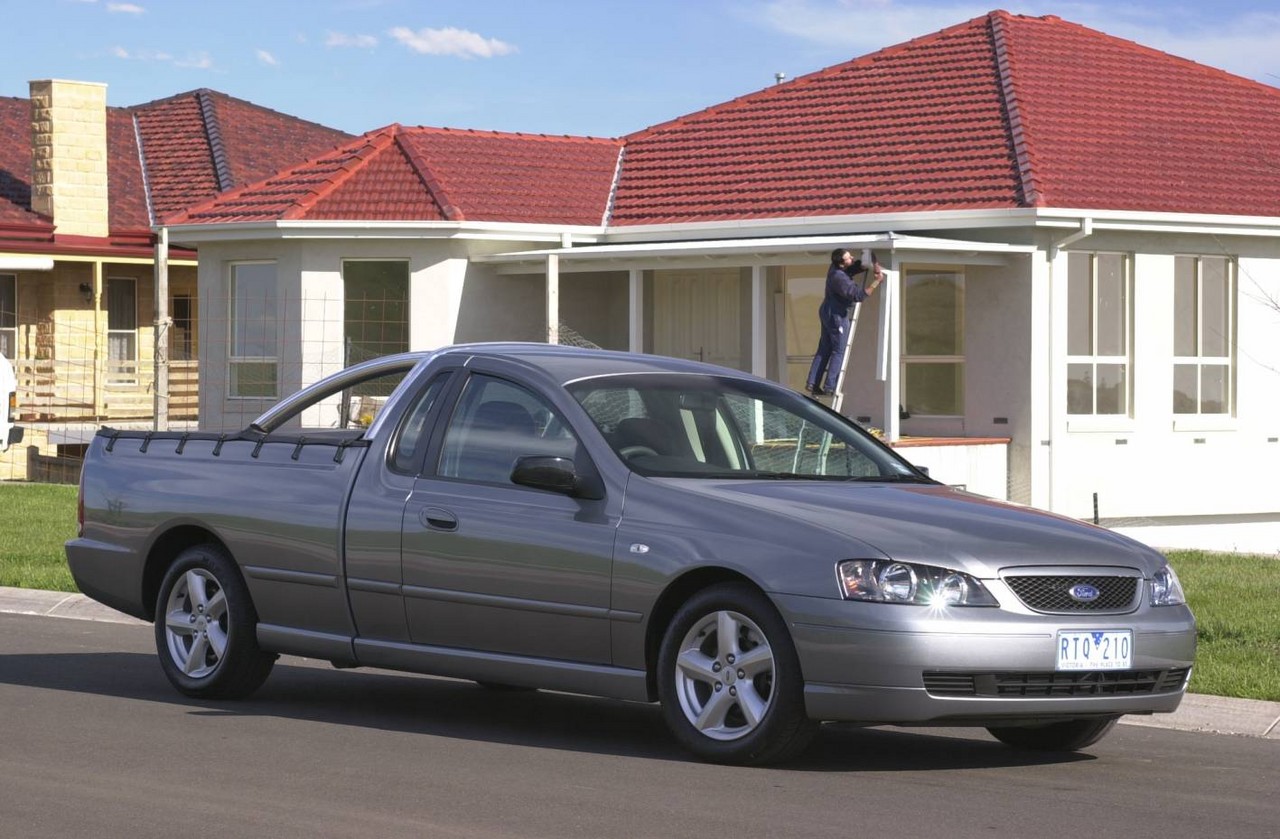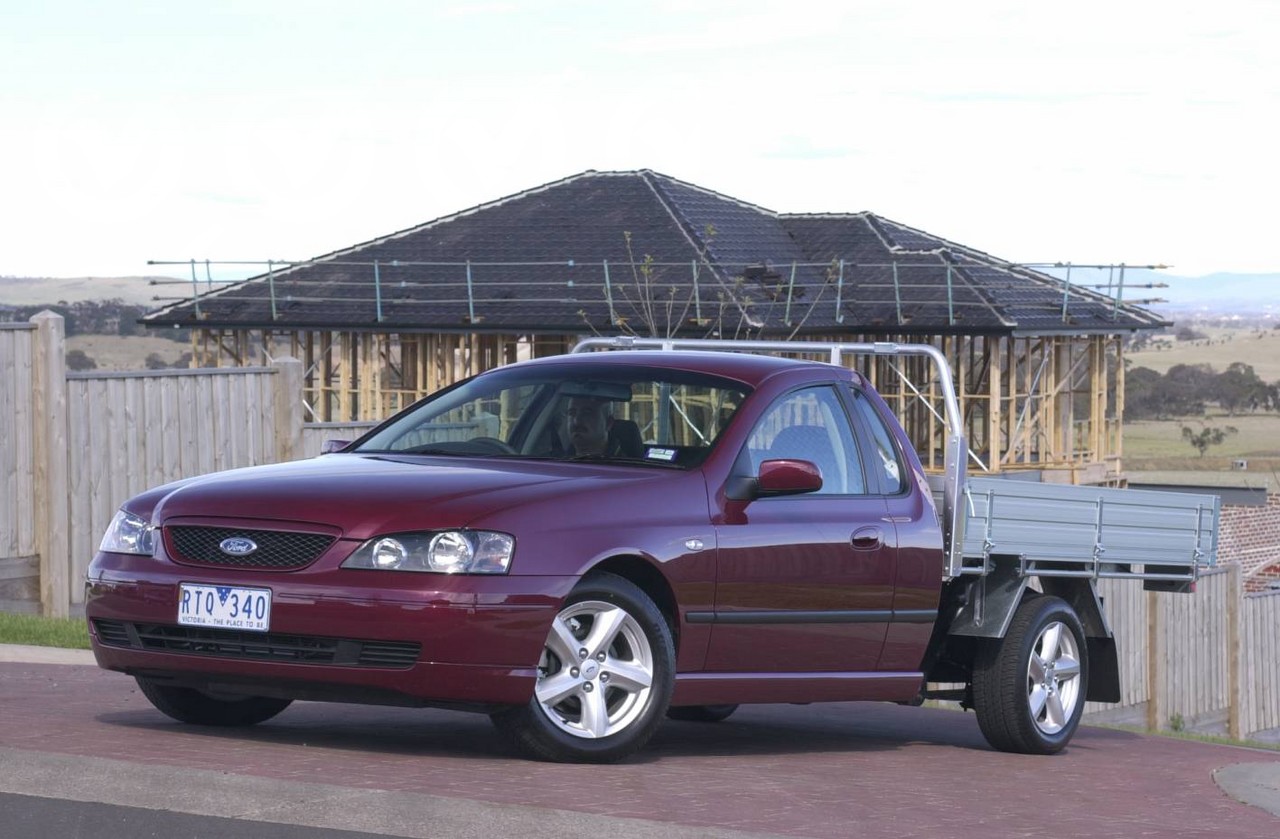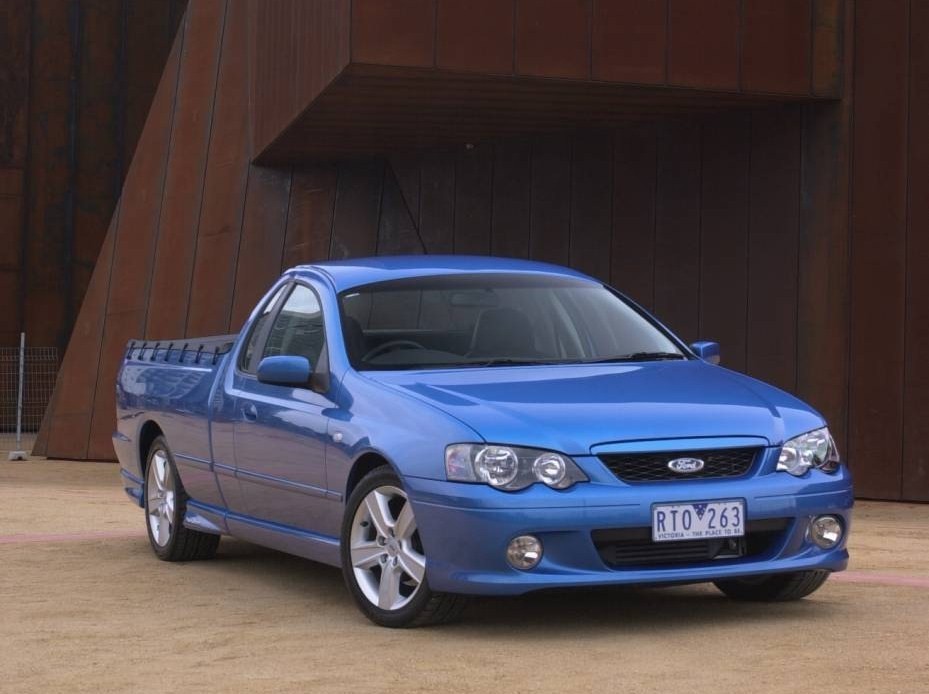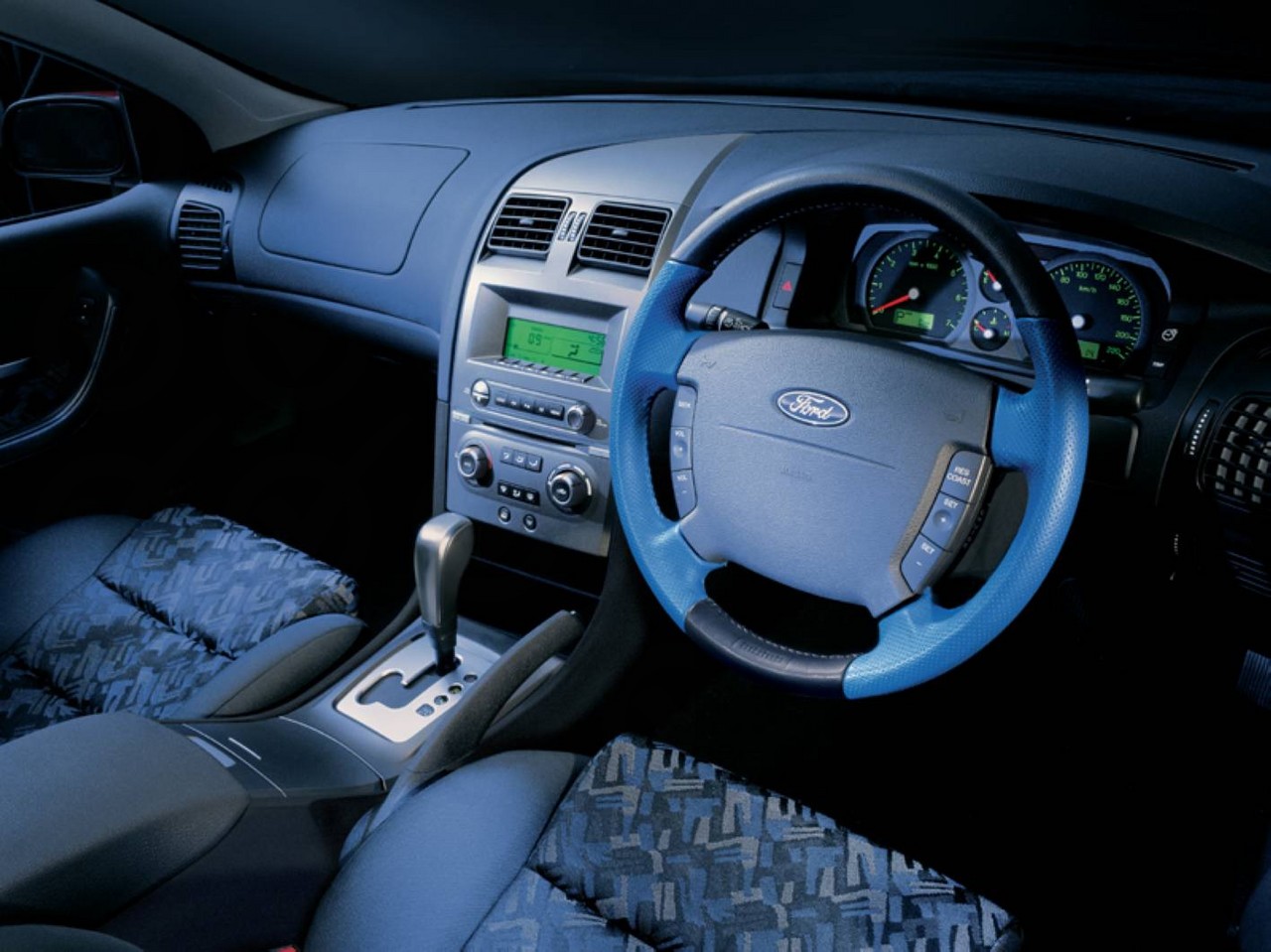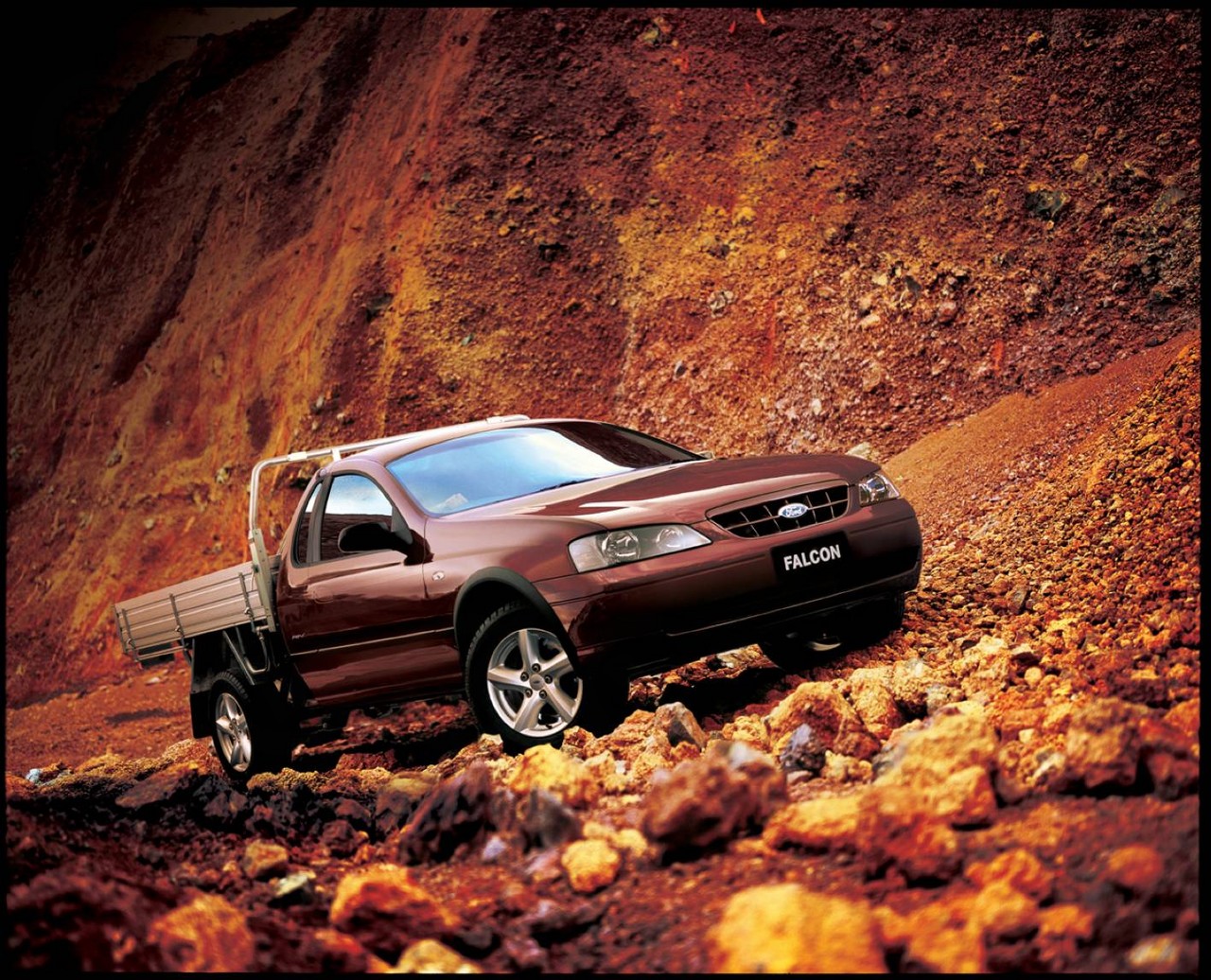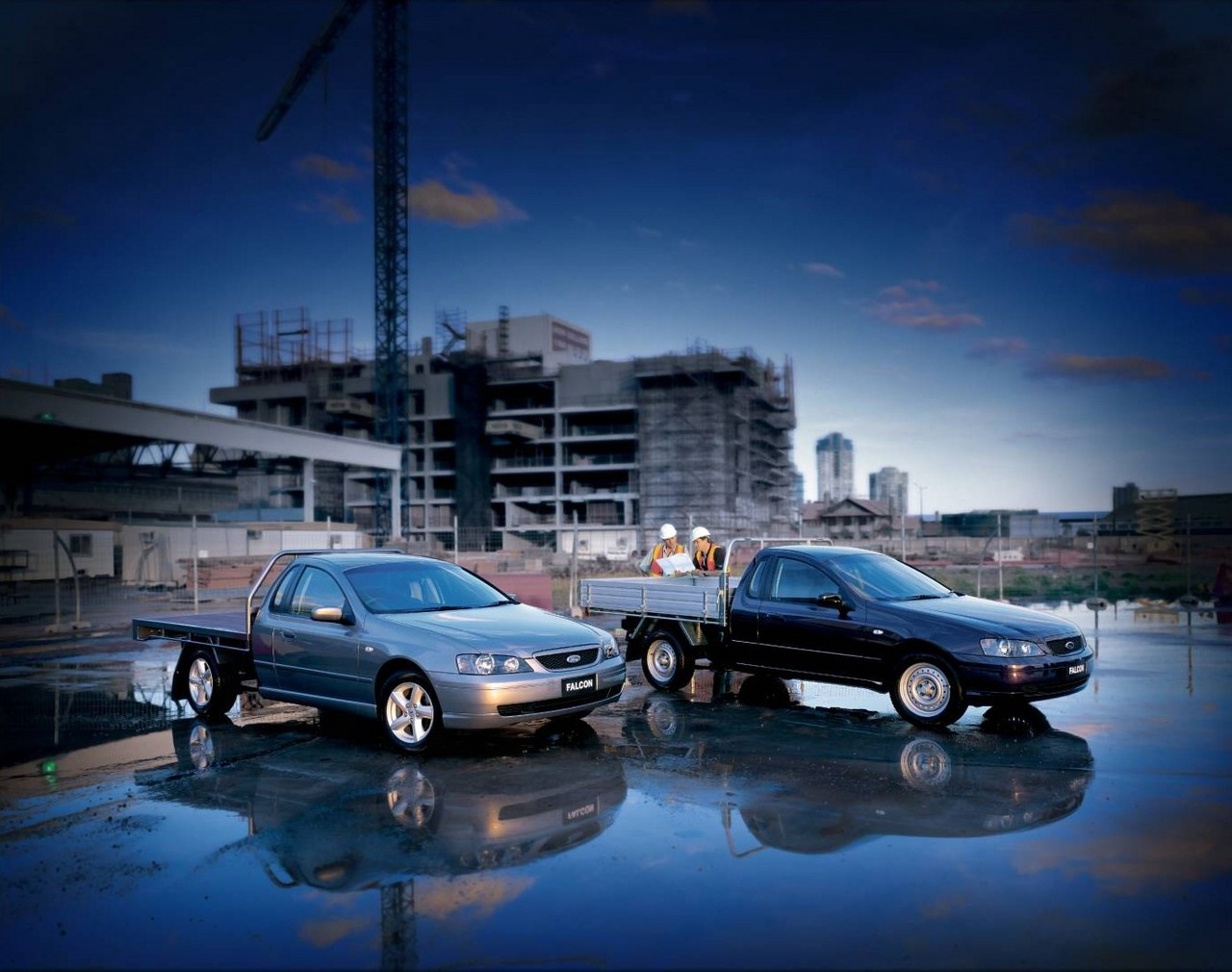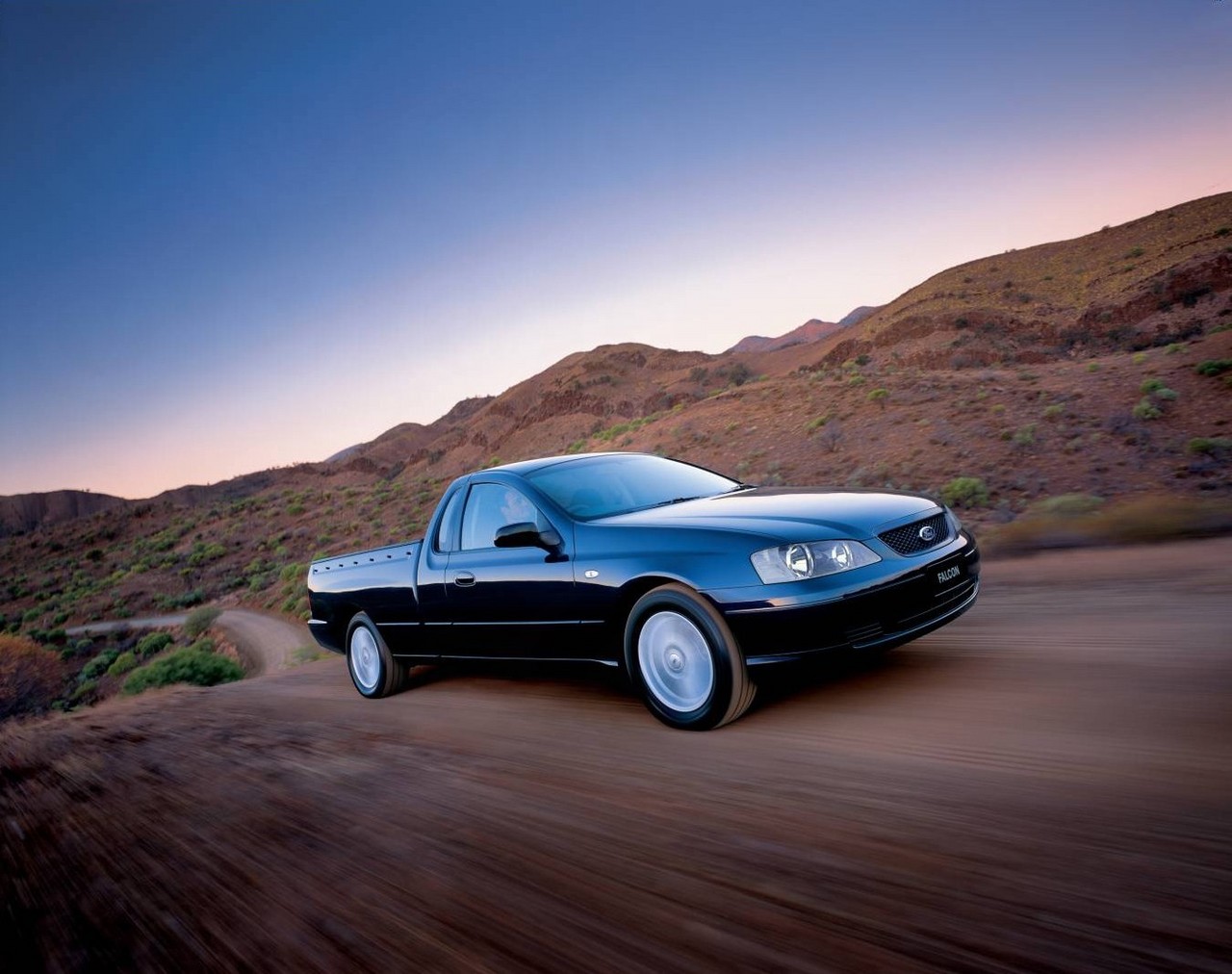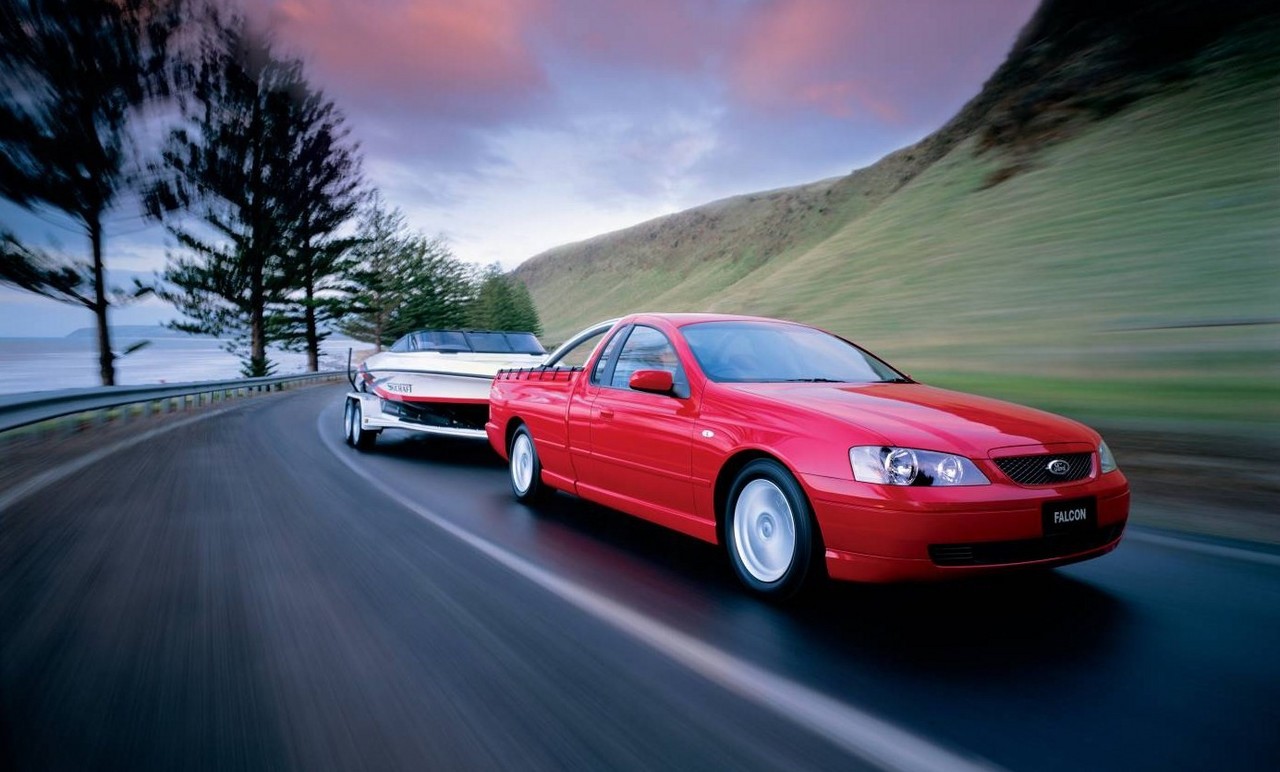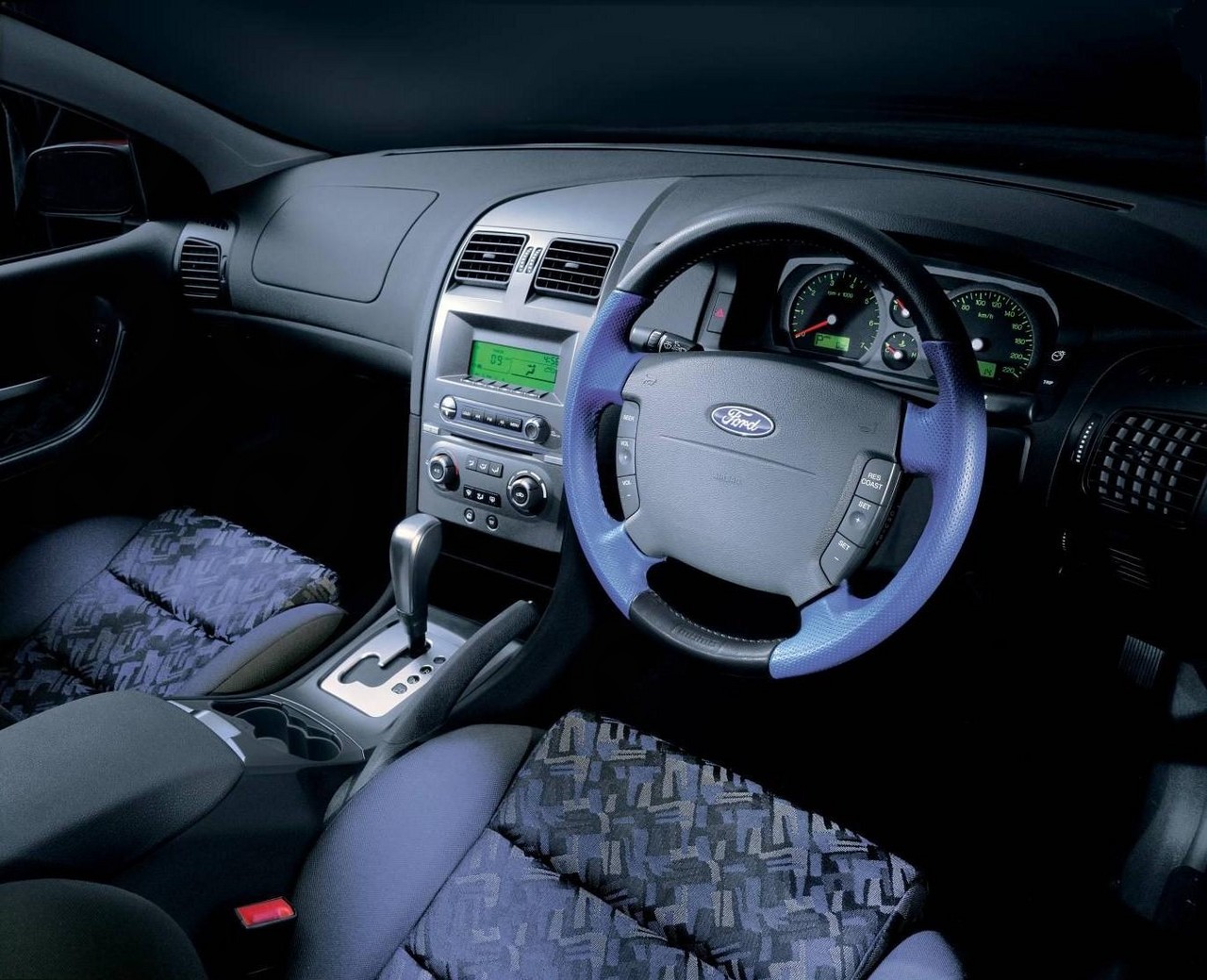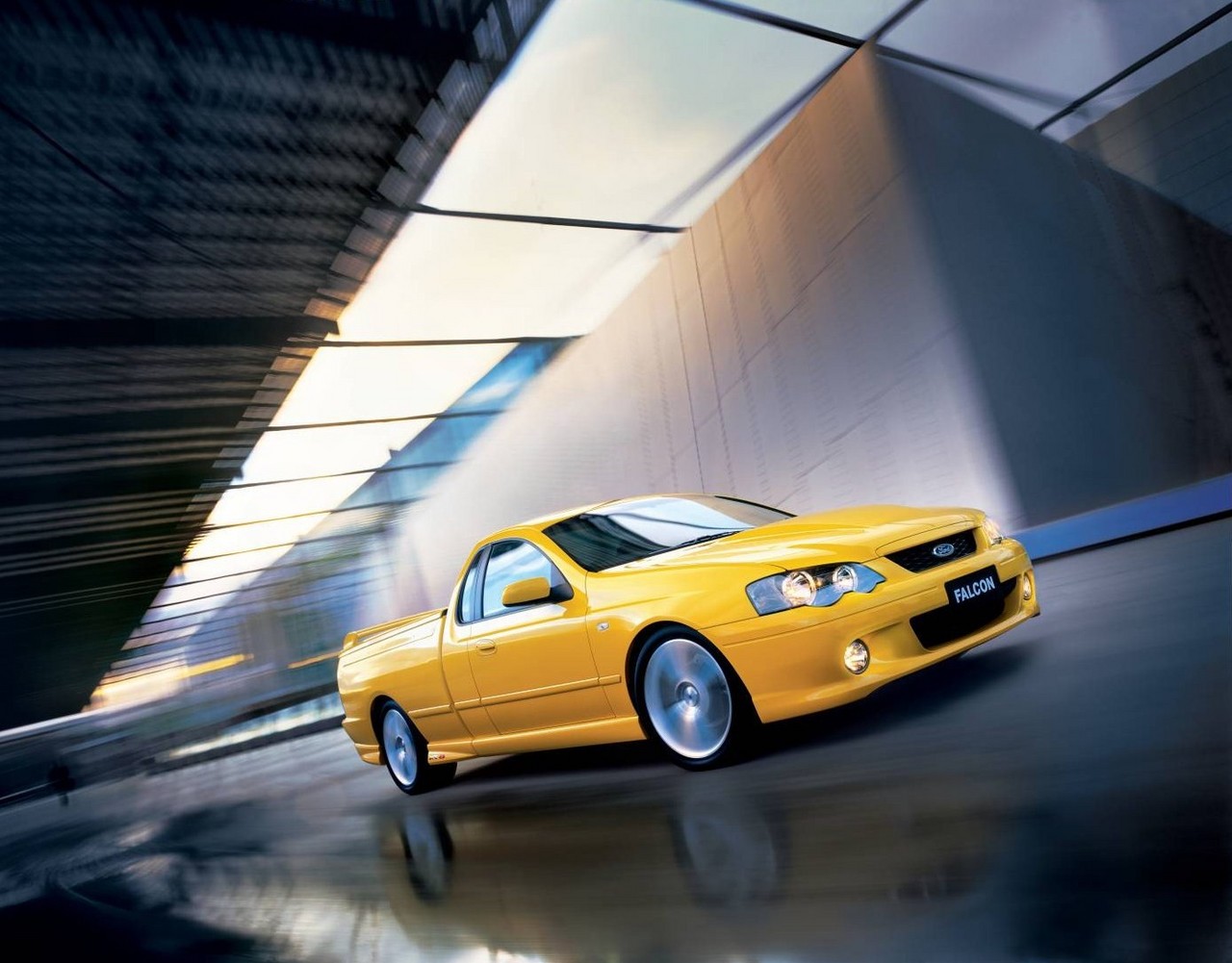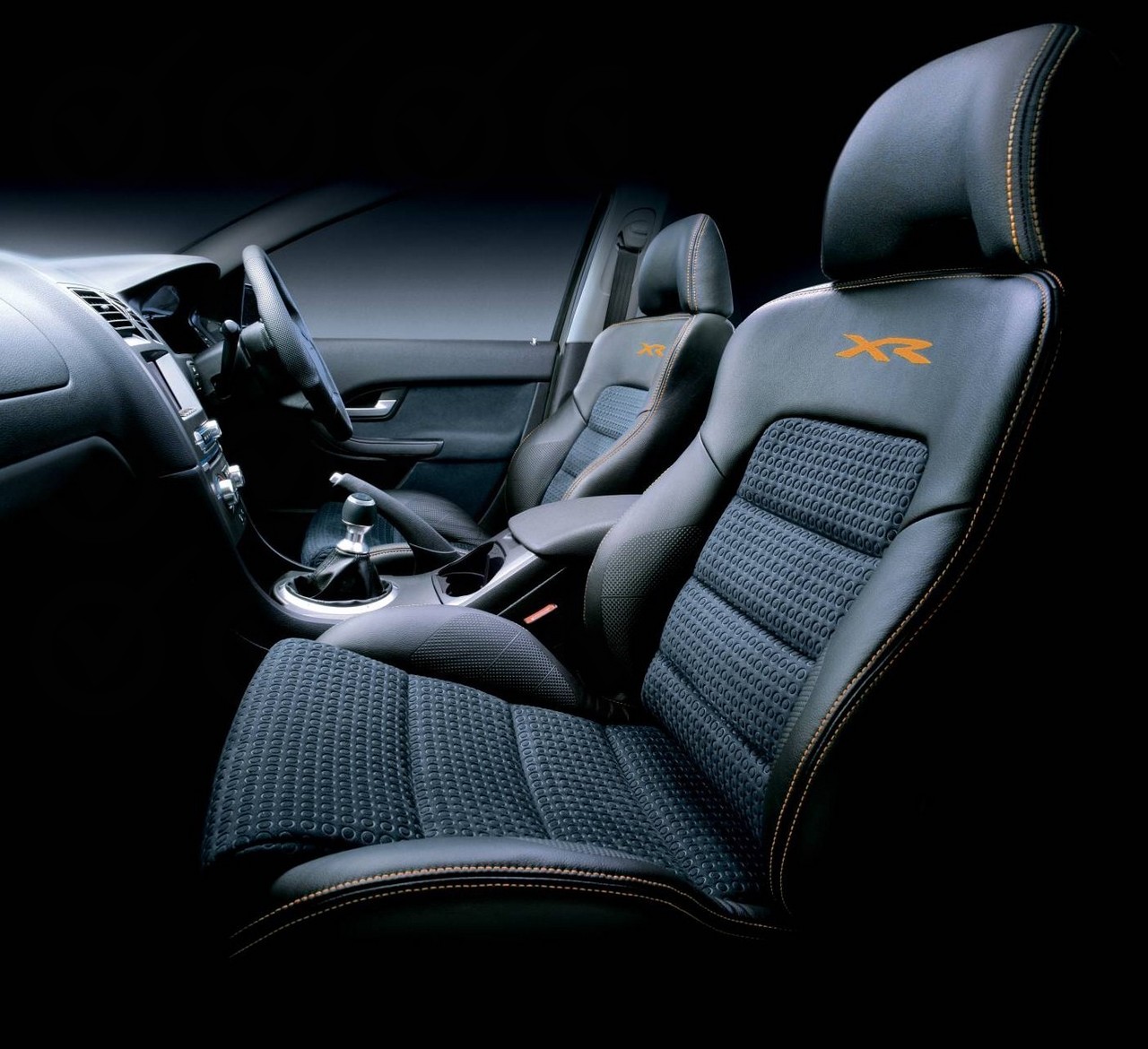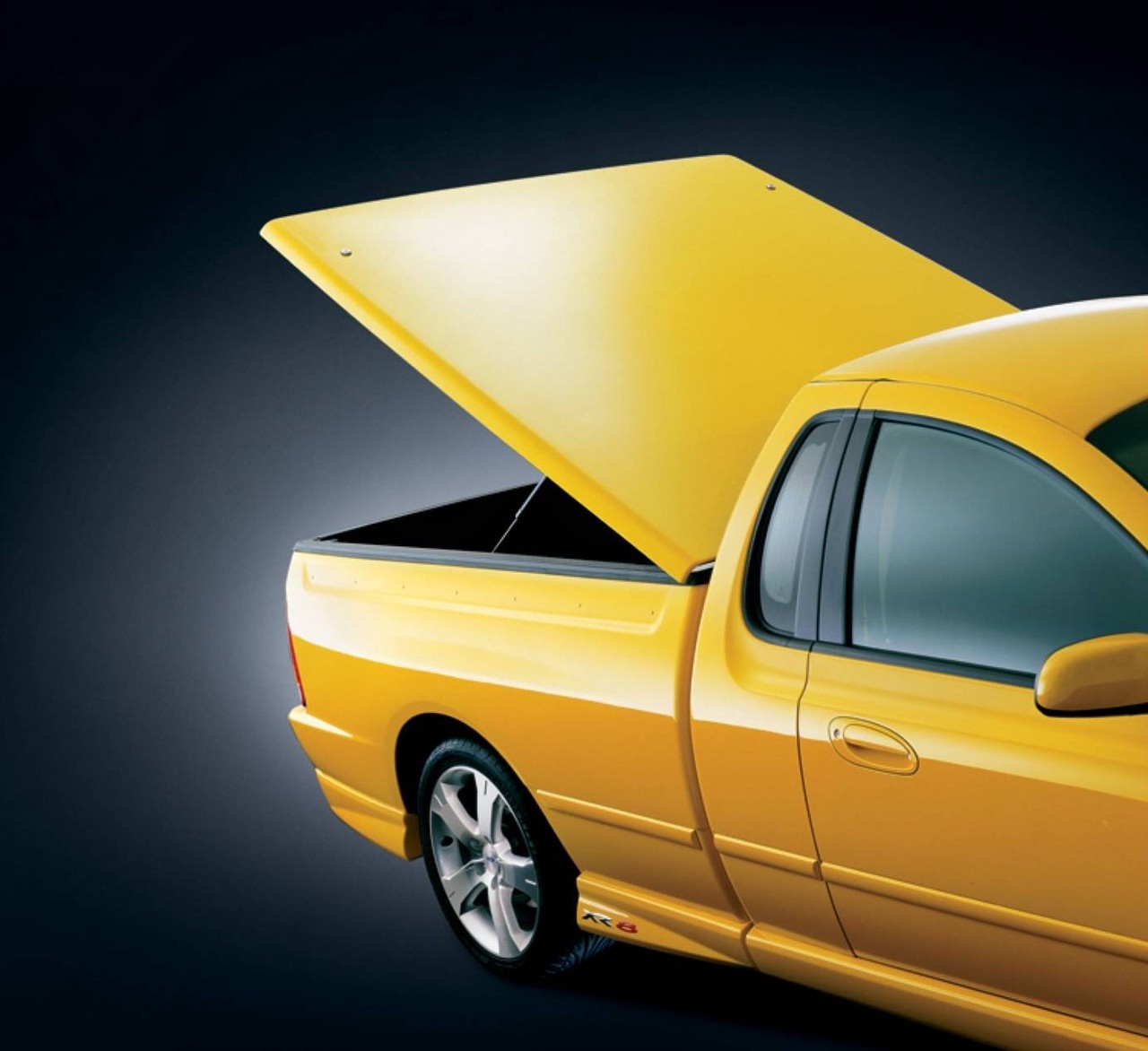
- Responsive 4.0-litre six-cylinder engine
- Powerful engines for XR6 Turbo and XR8
- Accomplished ride/handling balance
- Comfortable and spacious cabin
- For cab chassis models, large tray
- Limitations of leaf spring rear suspension on uneven surfaces
- Suspension, driveline and road noise
- Cast-iron 4.0-litre engines are heavy and not particularly fuel-efficient
- Low standard of interior fit and finish
- Overly sensitive steering
- Coolant lines for automatic transmission cooler susceptible to failure
Review: Ford BA.I Falcon Ute (2002-04)
Overview
Released in October 2002, the Ford BA Mark I (BA.I) Falcon Ute was available with either a cab chassis or integrated Styleside box body. Manufactured in Campbellfield, Victoria, the rear-wheel drive BA Falcon Ute was available with 4.0-litre petrol, 4.0-litre LPG and 5.4-litre petrol V8 engines. As per the table below, the BA.I Falcon Ute range initially consisted of XL, XLS, XR6, XR6 Turbo and XR8 variants, but was subsequently expanded with the RTV variant in September 2003.
Engines: Barra 182, Barra 240T, E-Gas LPG, Barra 220 and Boss 260
Of the engines,
- The 4.0-litre Barra 182 inline six-cylinder petrol engine had a cast iron block, a cast aluminium cylinder head, double overhead camshafts (DOHC, simplex chain-driven), dual infinitely variable camshaft adjustment (within a 60 degree range), four valves per cylinder, Duratec-style finger followers, a dual resonance inlet manifold, coil-on-plug ignition and a compression ratio of 9.7:1. Compared to its Intech predecessor, changes for the Barra six cylinder engine included a new cylinder head (50 per cent stiffer than its predecessor), forged camshafts (previously cast iron), new combustion chambers, port design, a single chain drive for the camshafts, electronic ‘drive by wire’ throttle control, internal exhaust gas recirculation, a crank-mounted oil pump, new knock sensors (for improved performance on premium unleaded fuel) and an upgraded Powertrain Control Module (PCM). The rev limit was also raised to 6000 rpm (previously 5700 rpm);
- The 4.0-litre Barra 240T engine added a Garrett GT3582R turbocharger which had engine oil-lubricated and water-cooled bearings, an air-to-air intercooler and an electronic single bypass wastegate. The turbocharger was mounted off a cast stainless steel exhaust manifold and provided maximum boost pressure of 6 psi (0.413 bar). Furthermore, the Barra 240T engine had a compression ratio of 8.7:1 and a 6000 rpm redline, while a knock sensor enabled the engine to run on regular unleaded fuel, though premium unleaded was recommended for optimum performance. Compared to the Barra 182 engine , the Barra 240T engine had new pistons with a ‘dished bowl’ shape and a fully floating gudgeon pin, more temperature tolerant exhaust valves, increased fuel pressure (4 bar, compared to 2.4 bar) and heavier duty lubricating oil. Heat shields were also installed to protect components such as the steering column assembly and the under floor area above the three-inch dump pipe and the catalysts;
- The 4.0-litre Barra E-Gas dedicated LPG engine had a Vialle closed-loop single-point carburetion system, hardened valves and valve seats, and a compression ratio of 10.7:1;
- Manufactured at Ford’s Windsor plant in Canada, the 5.4-litre Barra 220 V8 engine had a cast iron block, a cast aluminium cylinder head, sintered connecting rods, a single overhead camshaft (SOHC), variable intake camshaft timing (over 60 degrees relative to the crankshaft), three valves per cylinder (two intake, one exhaust), roller finger followers, coil on plug ignition and a compression ratio of 9.7:1. Compared to its 4.9-litre Windsor predecessor, changes included a stiffer block, reshaped pistons (with longer side skirts), magnesium cam covers, electronic throttle control, internal exhaust gas recirculation and failsafe-cooling protection (previously limited to inline six cylinder engines); and
- Assembled by hand in Campbellfield, the 5.4-litre Boss 260 V8 engine had double overhead camshafts, four valves per cylinder and a compression ratio of 9.52:1, but omitted the variable cam timing of the Barra 220. The Boss 260 engine combined the long stroke 5.4-litre block with Mustang Cobra R heads and changes included high-lift camshaft profiles, specific inlet camshaft to match the high-rise inlet manifold and exhaust header system, forged steel crankshaft, Boss fuel rail with upgraded injectors, 75 mm throttle body, low-restriction air-intake with a conical filter, 1 7/8inch stainless steel exhaust headers, and an FPV oil pan and oil pick-up.
Transmissions
Of the transmissions,
- The naturally aspirated six-cylinder engines were available with four-speed BTR M93LE automatic or five-speed BTR T5 manual transmissions;
- For the XR6 Turbo, the turbocharged six-cylinder engine was available with four-speed BTR M95LE automatic or five-speed BTR T5Z manual transmissions; and,
- The 5.4-litre V8 engine was available with four-speed BTR M97LE automatic or five-speed Tremec TR3650 manual transmissions.
For the BA range, changes for the automatic transmissions included a higher contact ratio gear set, a new design alloy plate (finned) transmission oil cooler and upgrades for the valve body, pump assemblies and torque converters. For the XR6 Turbo, its M95LE automatic transmission had an additional clutch pack, stronger gear set, reinforced torque converter and a Kevlar front band. Furthermore, all automatic transmissions had an adaptive shifting program, while all floor-shift automatic transmissions had a ‘Sequential Sports Shift’ function.
Development and dimensions
Compared to the AU Falcon Ute , the BA Falcon Ute had a significantly stiffer chassis. Other developments included:
- An intelligent crash sensor and restraint triggering system;
- A new alloy cross member under the transmission with alloy mountings;
- A stainless steel exhaust;
- A stiffer steering column, revised steering gear and a faster steering ratio (2.8 turns lock-to-lock);
- New hydraulic engine mounts; and,
- New insulating foam between the body and carpets.
The BA Styleside utility was 5077 mm long, 1871 mm wide, 1515 mm tall and had a 3096 mm long wheelbase; for cab chassis models that were fitted with an aluminium tray, length increased by 263 mm (to 5340 mm) and width by 37 mm (1908 mm).
Suspension
The Ford BA Falcon Ute had double wishbone front suspension and ‘Hotchkiss’ rear suspension which consisted of a live rear axle suspended by leaf springs. For the BA Falcon Ute, the rear shock absorbers had a greater diameter (36 mm, previously 30 mm for the AU) and provided less friction for improved ride comfort and greater resistance to overheating.
The BA Falcon Ute was available with Standards, Sports and One Tonne suspension tunes; for information on payloads, please see the ‘BA.I Falcon Ute Specifications’ download link, below.
| Body | Variant | Engine | Trans. | Peak power | Peak torque |
|---|---|---|---|---|---|
| Cab chassis | XL, Tradesman, SE, XLS, Marlin, RTV |
4.0-litre Barra 182 petrol I6 | 4sp auto, 5sp man. |
182 kW at 5000 rpm | 380 Nm at 3250 rpm |
| 4.0-litre Barra E-Gas LPG I6 | 4sp auto, 5sp man. |
156 kW at 4750 rpm | 372 Nm at 3000 rpm | ||
| 5.4-litre Barra 220 petrol V8 | 4sp auto, 5sp man. |
220 kW at 4750 rpm | 470 Nm at 3250-4000 rpm | ||
| Utility | XL, XLS, Marlin, RTV |
4.0-litre Barra 182 petrol I6 | 4sp auto, 5sp man. |
182 kW at 5000 rpm | 380 Nm at 3250 rpm |
| 4.0-litre Barra E-Gas LPG I6 | 4sp auto, 5sp man. |
156 kW at 4750 rpm | 372 Nm at 3000 rpm | ||
| 5.4-litre Barra 220 petrol V8 | 4sp auto, 5sp man. |
220 kW at 4750 rpm | 470 Nm at 3250-4000 rpm | ||
| XR6 | 4.0-litre Barra 182 petrol I6 | 4sp auto, 5sp man. |
182 kW at 5000 rpm | 380 Nm at 3250 rpm | |
| XR6 Turbo | 4.0-litre Barra 240T turbo petrol I6 | 4sp auto, 5sp man. |
240 kW at 5250 rpm | 450 Nm at 2000-4500 rpm | |
| XR8 | 5.4-litre Boss 260 petrol V8 | 4sp auto, 5sp man. |
260 kW at 5250 rpm | 500 Nm at 4250 rpm |
Safety equipment
Standard safety equipment for the BA.I Falcon Ute included a two-stage driver’s airbag and front seatbelts with pretensioners and load limiters; a passenger airbag was optional. The RTV, XR6, XR6 Turbo and XR8 were also fitted with ABS and electronic brake force distribution as standard.
Brakes
The standard braking package for the BA Falcon Ute consisted of 298 mm by 28 mm vented front brake discs with twin-piston aluminium callipers and 303 mm by 16 mm solid rear discs with single piston callipers. The optional premium braking package had 325 mm by 32 mm grooved front brake discs and 303 mm by 16 mm grooved rear discs.
ANCAP crash testing
In ANCAP crash testing , a BA.II Falcon Ute XR6 received a four star adult occupant protection rating with a score of 25.92. In the offset crash test, protection from serious chest injury was weak for both occupants; there was also a slight risk of serious lower leg injury for both occupants and a slight risk of neck injury for the passenger. In the side impact test, there was a marginal risk of serious chest injury for the driver.
Features: Falcon Ute XL and XLS
Standard features for the Ford BA Falcon Ute XL included a two speaker sound system with a CD player, a four-way power adjustable driver’s seat, manually adjustable front seat lumbar support, a speed alert, steering wheel audio controls, remote central locking, a tilt and reach adjustable steering wheel, height adjustable driver’s seat, trip computer and an immobiliser. Inside, there was a satin-finish centre console and ‘Interior Command Centre’ (ICC) with a large LCD.
The Styleside XL was fitted Dunlop 215/60 R16 tyres and standard suspension settings. The cab chassis XL, however, was fitted with the Dunlop 215/60 R16 C (Commercial) tyres and Ford’s ‘One Tonne Suspension’ set-up, including heavier leaf springs and a raised ride height. The One Tonne Suspension package was optional for the Styleside XL.
The Falcon Ute XLS featured Dunlop 215/55 R16 tyres with sports suspension (20mm lower ride height, stiffer front and rear springs and FPV-supplied sports shock) absorbers, stiff, a four speaker stereo with CD player, sports seats and cruise control.
Features: Falcon Ute XR, XR6 Turbo and XR8
The XR6 was further equipped with 17-inch alloy wheels (also with sports suspension), air conditioning and body kit, while the XR6 Turbo and XR8 were also fitted with a limited slip differential.
Features: Falcon Ute RTV
With respect to features, the RTV (an acronym for ‘Rugged Terrain Vehicle’ ) was similarly equipped to the XL but added 16-inch alloy wheels. However, the RTV was fitted with raised suspension (67.5 mm at the front and 80 mm at the rear for 215 mm ground clearance), a wider track (by 30 mm), a Dana/Spicer Model 86 rear axle, heavy duty radiator and underbody protection. The RTV also featured a lockable rear differential which enabled the left and right sections of the rear axle to form a solid driving axle for speeds below 40 km/h. The RTV was fitted with the One Tonne suspension package, adding anti-tramp rods to prevent axle tramp.
Limited Editions: Falcon Ute Tradesman, SE and Marlin
In August 2003 and subsequently in May 2004, limited-run Tradesman, SE and Marlin variants were released. Of these,
- The cab chassis Tradesman was based on the XL but added one-tonne rated 16-inch alloy wheels and an aluminium tray (or $1000 towards a custom tray);
- The SE was based on the XL, but further equipped with one-tonne rated 16-inch alloy wheels, air-conditioning, a chrome exhaust tip and SE decals; and,
- Compared to the XLS, the Marlin was distinguished by its air conditioning, a polished aluminium sports bar (with compatible tonneau cover), side skirts, body-coloured side protection mouldings and ‘Marlin’ decals.
Related links
Review: Ford BA.II Falcon Ute (2004-05)
Overview
Released in October 2004, the BA Mark II (BA.II) Falcon Ute introduced improved equipment levels and a six-speed manual transmission. The range itself was substantially unchanged, though the Tremec T56 six-speed manual transmission was available in the XR6 Turbo and XR8 variants.
Previously used in the Mustang Cobra R , the Tremec T56 manual transmission had double synchros in its forward gears and a single synchro in reverse. With the T56 transmission, the final drive ratios for the XR6 Turbo and XR8 were 3.73:1 (previously 3.46:1) and 3.46:1 (previously 3.23:1).
| Body | Variant | Engine | Trans. | Peak power | Peak torque |
|---|---|---|---|---|---|
| Cab chassis | XL, Tradesman, XLS, RTV |
4.0-litre Barra 182 petrol I6 | 4sp auto, 5sp man. |
182 kW at 5000 rpm | 380 Nm at 3250 rpm |
| 4.0-litre Barra E-Gas LPG I6 | 4sp auto, 5sp man. |
156 kW at 4750 rpm | 372 Nm at 3000 rpm | ||
| 5.4-litre Barra 220 petrol V8 | 4sp auto, 5sp man. |
220 kW at 4750 rpm | 470 Nm at 3250-4000 rpm | ||
| Utility | XL, SE, XLS, RTV |
4.0-litre Barra 182 petrol I6 | 4sp auto, 5sp man. |
182 kW at 5000 rpm | 380 Nm at 3250 rpm |
| 4.0-litre Barra E-Gas LPG I6 | 4sp auto, 5sp man. |
156 kW at 4750 rpm | 372 Nm at 3000 rpm | ||
| 5.4-litre Barra 220 petrol V8 | 4sp auto, 5sp man. |
220 kW at 4750 rpm | 470 Nm at 3250-4000 rpm | ||
| XR6 | 4.0-litre Barra 182 petrol I6 | 4sp auto, 5sp man. |
182 kW at 5000 rpm | 380 Nm at 3250 rpm | |
| XR6 Turbo | 4.0-litre Barra 240T turbo petrol I6 | 4sp auto, 6sp man. |
240 kW at 5250 rpm | 450 Nm at 2000-4500 rpm | |
| XR8 | 5.4-litre Boss 260 petrol V8 | 4sp auto, 6sp man. |
260 kW at 5250 rpm | 500 Nm at 4250 rpm |
Features
Compared to its BA.I predecessor, standard features for the Ford BA.II Falcon Ute were extended to include automatic headlights, a second remote key fob and variable dwell and speed-sensitive wipers.
The Falcon Ute XLS was fitted with one-tonne suspension settings for the cab chassis models, new side skirts and body-coloured side protection mouldings.
The Falcon Ute XR6, XR6 Turbo and XR8 were fitted with new 17-inch alloy wheels and alloy pedal covers.
2005 Falcon Ute Tradesman and SE
In March 2005, limited-run Tradesman and SE variants were released, based on the XL variant. Compared to the XL, the Tradesman added 16-inch alloy wheels and an aluminium tray; the SE added 16-inch alloy wheels and air conditioning.
2005 Falcon Ute XR6, XR6 Turbo and XR8 Magnet
Magnet editions of the XR6, XR6 Turbo and XR8 variants were released in March 2005. The Magnet editions were distinguished by their 18-inch alloy wheels, sports leather seats and a leather-wrapped Momo steering wheel.
Related links
